Most bodyweight quad workout articles are recycled garbage, recommending the same basic squats you’ve been doing since middle school gym class.
NO doubt squat is the BEST, one.
But after spending 10+ years as a fitness coach (and personally testing hundreds of exercises), I’ve discovered that the many best bodyweight exercises to build bigger quads at home.
In this guide, I share the 12 bodyweight quad exercises that consistently deliver results for my clients.
And will produce the same for you.
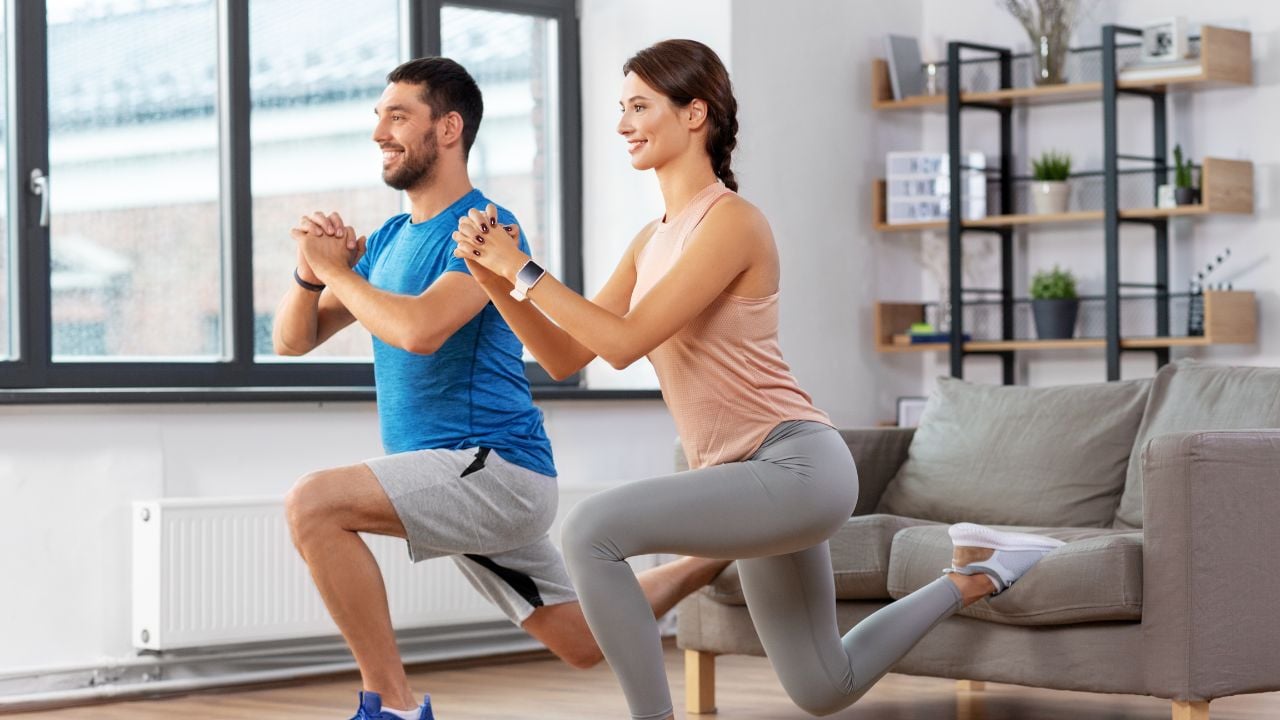
- Best Bodyweight Quad Exercises You Can Do Anywhere
- 1. Bodyweight Squat
- 2. Bodyweight Split Squat
- 3. Step-Up
- 4. Bulgarian Split Squat
- 5. Bodyweight Sumo Squat
- 6. Jump Squat
- 7. Pistol Squat
- 8. Wall Sit
- 9. Side Lunge
- 10. Seated Knee Extension
- 11. Box Jump
- 12. Bear Crawl
- Quadriceps Muscles (Anatomy)
- Takeaways
- References
Best Bodyweight Quad Exercises You Can Do Anywhere
You don’t need a gym or weights to build strong, toned quads. Bodyweight exercises can be just as effective in targeting and strengthening your leg muscles.
Here are 12 quad exercises you can do at home or anywhere without any equipment.
1. Bodyweight Squat
Bodyweight squats are among the top and most-used exercises. They increase the strength and size of the lower body (leg) muscles and develop core strength.
The primary muscles that work during the squat are the quadriceps, and the secondary muscles are the glutes and the hamstrings. It also isometrically uses the erector spinae and the abdominal muscles.
It can be performed virtually anywhere with no equipment and limited space. It’s a highly functional movement that works all the major muscles of the legs.
This is one of my favourite leg exercises. Sometimes I do 300–400 reps during my leg workout day.
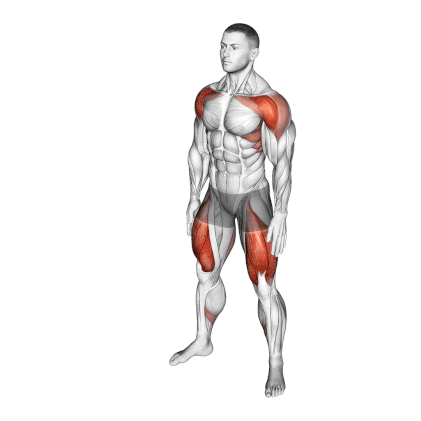
How To Do
- Stand with your feet slightly wider than shoulder-width apart. Your toes can point straight ahead or slightly outwards (5-15 degrees is a good starting point – find what feels natural for your hips).
- Before you even think about moving, brace your core. Imagine someone is about to punch you in the stomach lightly. This creates intra-abdominal pressure, protecting your spine.
- Start the movement by slightly hunching at your hips, sending them backward as if you are about to sit in a chair that is slightly behind you.
- When lowering yourself, be careful not to extend your knee past your toes. Also, don’t let them cave inwards (valgus collapse).
- Try to get your thighs parallel to the floor. If your mobility allows, go deeper, as this maximises muscle activation.
- To get back up, drive through your entire foot. Extend your hips and knees simultaneously. Squeeze your glutes at the top to complete the movement, but avoid overextending your lower back.
- Inhale as you lower, exhale as you drive up. For heavier/more intense efforts, you can take a breath at the top, hold it (Valsalva maneuver) during the descent and initial ascent, and then exhale.
2. Bodyweight Split Squat
The bodyweight split squat is a unilateral (single-leg) exercise that builds lower body strength, balance, and stability.
I use this movement regularly with clients to identify and correct imbalances, enhance athletic performance, and increase functional strength
By removing one leg from the primary “pushing” equation (the back leg is mostly for balance and support), you’re effectively increasing the load and the required range of motion for the front leg’s quads.
Bodyweight lunges are an exercise that targets the quadriceps, glutes, hamstrings, and core and lower back muscles.
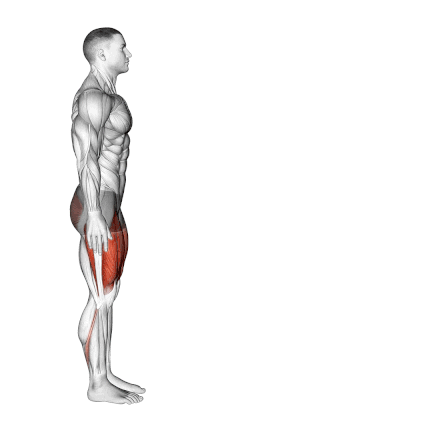
How To Do
- Take a comfortable step forward with one leg, as if you’ve just finished a lunge. Your feet should be hip-width apart (imagine you’re standing on two separate railway tracks).
- The length of your stride should be such that when you lower, your front shin is roughly vertical (or your knee is over your ankle/midfoot), and your back knee can comfortably bend towards the floor.
- Most of your weight (around 80-90%) should be on your front foot. The back foot, resting on the ball of the foot, is primarily for balance.
- Brace your core (as always) and keep your torso upright. Your chest should be proud, and your gaze should be forward. Avoid leaning too far forward or rounding your back.
- Lower your body by bending both knees simultaneously.
- Make sure that your back knee almost touches the floor or just taps it lightly. Your front thigh should be at least parallel to the floor.
- To return to your starting position, drive forcefully through your front foot (heel and midfoot). Extend your front knee and hip.
- Complete all reps on one side before switching to the other.
3. Step-Up
The step-up primarily targets the muscles responsible for Knee Extension (Quads) and Hip Extension (Glutes & Hamstrings).
- A lower box/step will tend to be more quad-dominant because the primary movement is knee extension over a shorter range of hip flexion.
- A higher box (e.g., knee at 90 degrees or more at the start) will involve more hip flexion and thus bring in more glute and hamstring activation to extend the hip.
This versatile workout is suitable for everyone. It can be adjusted to be challenging or easy for anyone, regardless of their fitness level or experience.
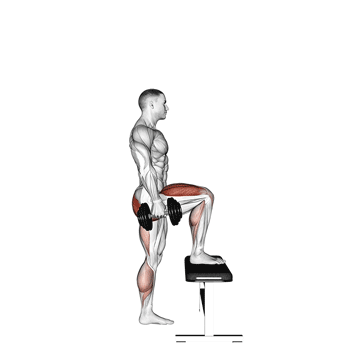
How To Do
- Choose a sturdy box, bench, or step. A good starting point is a height where your thigh is roughly parallel to the floor when your lead foot is on the step and your knee is bent at about 90 degrees.
- Beginners should start lower. A slightly lower box that allows for good knee flexion without excessive hip flexion is ideal for more quad emphasis.
- Stand facing the step. Firmly place one foot on the center of the step. Your weight should be distributed through this lead foot.
- Push your body upwards by driving through the heel and midfoot of your lead leg until your lead leg is straight, and you are standing tall on the step.
- Minimise pushing off with your back leg. The goal is for the lead leg to do almost all the work. Think of your back leg as just being there for balance initially.
- Lower your non-working leg back down to the floor slowly
- Complete all reps on one leg before switching to the other to maximise time under tension.
4. Bulgarian Split Squat
The Bulgarian Split Squat enhances the benefits of a regular split squat by elevating the rear foot.
The elevated rear foot provides minimal assistance (mostly just balance); virtually all your bodyweight is supported and moved by the front working leg.
This increased ROM means greater stretch and tension on the quads of the front leg through a longer path of movement. This also challenges your stabilising muscles, particularly around the hip (gluteus medius) and core, to balance the body during movement.
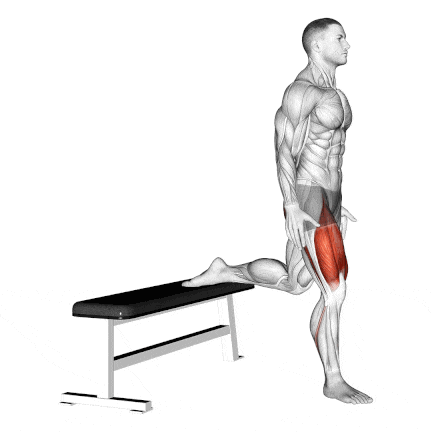
How To Do
- You’ll need a sturdy bench, box, or even a low chair. A good height is typically around knee height or slightly lower. Too high can cause discomfort in the back leg or excessive lower back arching.
- Place the top of your rear foot (Shoelaces Down) on the bench behind you.
- Extend one leg straight out in front of you, heel on the floor. Place your foot flat where your heel is. Now, stand up into the split squat position.
- Keep your front foot hip-width apart from where your back foot is anchored.
- Brace your core hard. Keep your chest up. A slight forward lean of the torso is natural and often necessary to maintain balance and allow for proper hip mechanics.
- Bend your front and back knees so that your front thigh is at least parallel to the floor, or ideally, for the hamstring of your front leg to touch your calf.
- Drive through the heel of your front foot to extend your knee and hip, returning to the starting position.
- Complete the desired reps on one leg, then switch sides.
5. Bodyweight Sumo Squat
The Sumo Squat is a lower-body strength exercise that is a standard squat variation. The key difference in this squat is that you take a wider stance and position your feet turned out.
While all squats work the glutes, hip flexors, quads, hamstrings, and calves, the leg positioning of the sumo squat also works the inner thighs.
When performed in high volume, the sumo squat is a great movement option for a high-intensity interval training (HIIT) workout.
Because the move recruits multiple large muscle groups in the legs, glutes, and core, its calorie-burning potential is high.
And there have been many research papers that have investigated the effects of squats on testosterone levels.
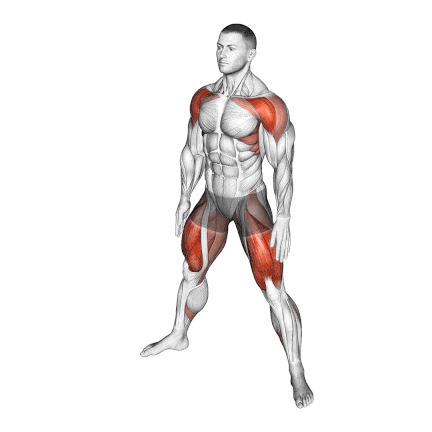
How To Do
- Stand with your feet significantly wider than shoulder-width apart (1.5 to 2 times), depending on your hip mobility and comfort.
- Point your toes outwards (30-45 degree angle), or even slightly more if your hip mobility allows. Your knees should be able to track in line with your toes.
- Brace your core tightly. Keep your chest up and proud, and try to maintain a relatively upright torso.
- Lower your body by bending at the hips and knees, so that your thighs are at least parallel to the floor.
- Actively push your knees outwards so they track in line with your toes. Don’t let them cave inwards.
- Drive through your entire foot (heels and midfoot), powerfully extending your hips and knees. Squeeze your glutes and adductors at the top to complete the movement.
6. Jump Squat
The jump squat is a dynamic plyometric exercise that combines a traditional squat with an explosive vertical jump.
It is widely used to develop lower-body power, improve athletic performance, and increase muscle strength and speed. This exercise recruits multiple muscle groups and challenges coordination, balance, and neuromuscular control.
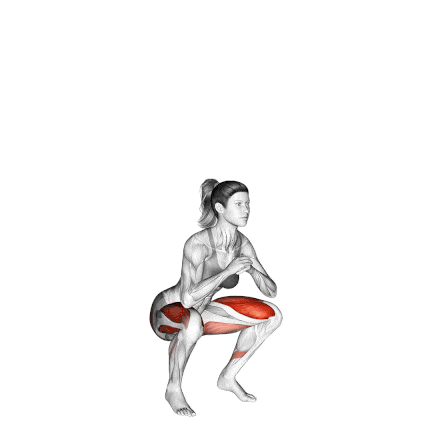
How To Do
- Start with your feet shoulder-width apart, or slightly wider, toes pointing slightly outwards (similar to a regular squat).
- Lower yourself into a squat, with your legs ideally parallel to the floor or just slightly above. Think of it as coiling a spring.
- As soon as you hit your desired depth, immediately and explosively drive through the balls of your feet, extending your hips, knees, and ankles (triple extension) to jump as high as possible. Swing your arms upwards to help generate momentum.
- Land softly on the balls of your feet first, then roll back towards your heels.
- Immediately absorb the impact by bending your knees and hips, returning to a squat position.
- You can either pause briefly after landing to reset for the next rep (good for beginners or focusing on max height per jump) or immediately flow into the next jump (more demanding, good for conditioning).
7. Pistol Squat
The pistol squat is an advanced single-leg squat variation that combines strength, balance, flexibility, and mobility. It challenges the entire lower body and core and requires significant control and coordination.
The unilateral movement strengthens the glutes, quadriceps, hamstrings, hip adductors (the muscles along the inner thigh), calves, and core muscles through a full range of motion while training balance and stability.
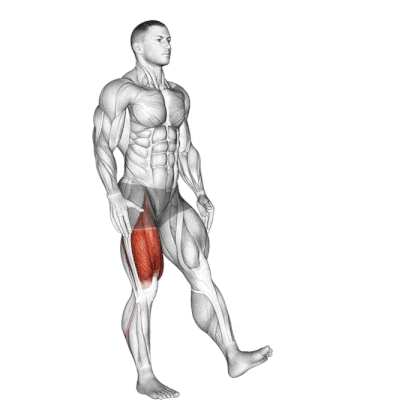
How To Do
- Stand with your feet hip-width apart and your arms extended in front of you.
- Lift your left foot off the ground and straighten it out in front of you.
- Slowly lower your body down into a squat position on your left leg.
- keep your torso upright and your right leg straight.
- Lower your body until your right thigh is parallel to the ground or as low as you can comfortably go.
- Push through your left heel to return to the starting position and repeat for reps or time.
- Then, switch legs and repeat on the other side.
- You can also perform assisted pistol squats by holding on to a TRX or any stable object to help you balance.
8. Wall Sit
The wall sit is a simple yet highly effective isometric exercise that targets the quadriceps and engages multiple lower body and core muscles.
The magic of the wall sit lies in the continuous tension it places on your quadriceps. As you hold the position, your quads work tirelessly to maintain knee extension against gravity and your body weight.
You can add a weight or a medicine ball to your chest to make the exercise harder.
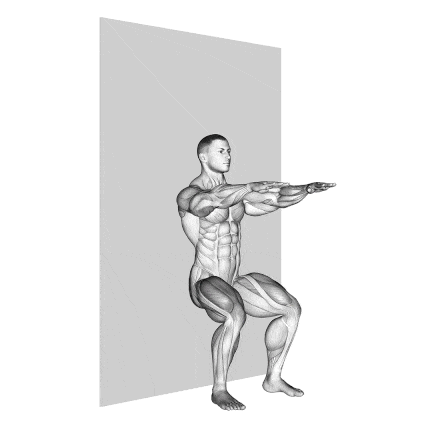
- Stand with your back against a wall and your feet hip-width apart, about 2 feet away from the wall.
- Slowly slide down the wall until your knees are bent at a 90-degree angle, as if you were sitting in an imaginary chair.
- Keep your weight in your heels and your toes pointing straight ahead.
- Engage your core and keep your back flat against the wall.
- Start with shorter holds and gradually increase the time, then progressively increase the holding time.
- Slowly slide back up the wall to the starting position and repeat for reps or time.
9. Side Lunge
The bodyweight lateral lunge is the best variation of the bodyweight lunge that people typically perform when they want a little more glute involvement with the movement pattern.
It effectively targets the quadriceps, glutes, adductors (inner thighs), abductors (outer thighs), and hamstrings.
Most traditional leg exercises (squats, deadlifts, forward lunges) occur in the sagittal plane (forward and backwards movement). Side lunges train your body to move and stabilise in the frontal plane (side-to-side), which is vital for agility and injury prevention.
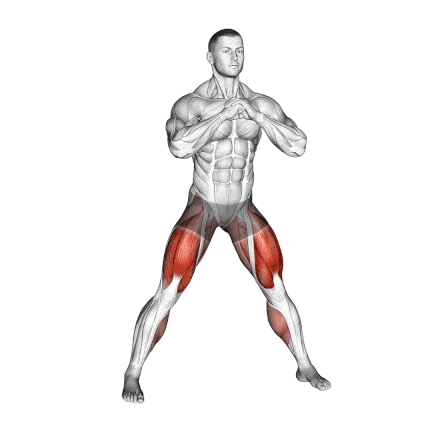
How To Do
- Stand with your feet hip-width apart, your toes pointing forward, your core engaged, and your chest up.
- Take a wide step directly to one side (e.g., to your left). Keep your toes on both feet pointing generally forward.
- Lower yourself until the thigh of your lunging leg is close to parallel with the floor (or as low as your mobility allows).
- Think of it like sitting back into a chair with one leg. Most of the movement should be a hip hinge on the lunging side.
- Keep most of your weight on the heel/midfoot of your lunging leg. Your trailing leg remains straight with the foot flat on the floor.
- Ensure the knee of your lunging leg is aligned with your toes; don’t let it cave inwards.
- Push yourself back to the starting standing position by driving forcefully off the foot of your lunging leg and extending your hip and knee.
- You can alternate legs with each rep or complete all reps on one side.
10. Seated Knee Extension
Seated knee extensions are a commonly prescribed exercise in physical rehabilitation programs.
This exercise isolates the knee extension mechanics to gently strengthen the knee joint and quads with minimal impact or excessive movement.
It is beneficial when the knee has a limited range of motion or when other leg parts need to remain immobile during rehabilitation.
A study has shown that knee extensions with an elastic band result in significantly higher voluntary peak quadriceps muscle activity than knee extensions in a machine.
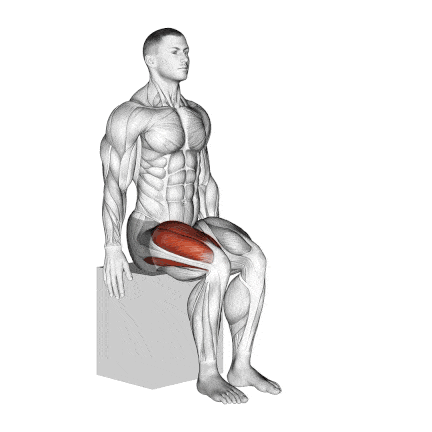
How To Do
- Sit on a chair or bench with your back straight and feet flat on the ground. Keep your back straight and avoid hunching over.
- Place a rolled-up towel or cushion under your thigh so your knee is slightly off the edge of the seat.
- Slowly straighten your knee, lifting your foot up towards the ceiling.
- Hold the position for a few seconds.
- Then, slowly lower your foot back down to the starting position.
- Repeat 12-15 repetitions, then switch legs.
11. Box Jump
The box jump is a plyometric exercise that develops an athlete’s lower body explosiveness and proprioception.
This exercise is commonly used as part of an athletic training circuit. It provides both leg muscle training stimulus and sports-specific skill development, such as proprioception, lower body stability, and multi-joint movement coordination.
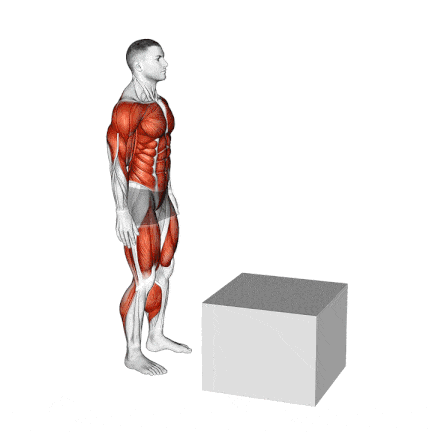
How To Do
- Start with a lower box height and increase it as you get stronger and more skilled.
- Use a sturdy box or platform to support your weight and prevent it from slipping or sliding during the exercise.
- Stand before a sturdy box or platform with your feet shoulder-width apart.
- Lower yourself into a quarter squat position, swinging your arms back for momentum.
- Explosively jump upwards, swinging your arms forward to help propel you upwards.
- Land on the box with both feet, ensuring you have fully extended your hips and knees at the top of the jump.
- Step back down from the box and repeat for the desired reps.
12. Bear Crawl
The bear crawl is a good exercise to add to a quad workout, though it functions primarily as a full-body, multi-muscle movement rather than an isolated quad exercise.
It effectively engages the quadriceps, glutes, hamstrings, core, shoulders, and hips.
This exercise is commonly used in agility workouts and has been shown to help athletes adapt to the physical and physiological demands of various training phases.
You can make the exercise more challenging by crawling backwards or laterally or adding a push-up at each step.
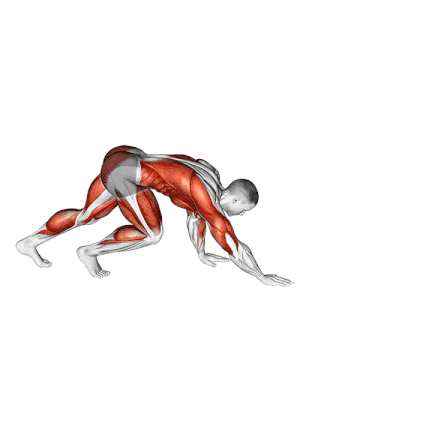
How To Do
- Get on all fours with your hands directly beneath your shoulders and your knees beneath your hips.
- Keep your hips and knees bent at a 90-degree angle, and your back straight.
- Move one hand forward a short distance. Simultaneously, move the opposite foot forward the same short distance, keeping your knees low.
- Repeat with the other hand and its opposite foot. So, if you move your right hand forward, you simultaneously move your left foot forward.
- Avoid letting your hips sag or pike up. Imagine balancing a glass of water on your lower back.
- Continue crawling forward for a set distance or time.
Note:
A study compared muscle responses in young (25-year-old) and older (70-year-old) adults during different exercises. Older adults showed higher muscle activity than younger adults, especially with elastic bands and machine exercises. This could guide effective exercise for age-related muscle strength.
You can also try resistance band quad exercises to build stronger legs at home.
Quadriceps Muscles (Anatomy)
The quadriceps muscles, commonly referred to as “quads,” are a group of four muscles located in the front of the thigh.
These muscles work together to extend the knee joint and flex the hip joint.
It has four separate heads:
- Rectus femoris arises from the front of the pelvic bone.
- Vastus medialis arises from the inner edge of the femur.
- Vastus lateralis arises from the outer edge of the femur.
- Vastus intermedius arises from the front surface of the femur and lies underneath the rectus femoris.
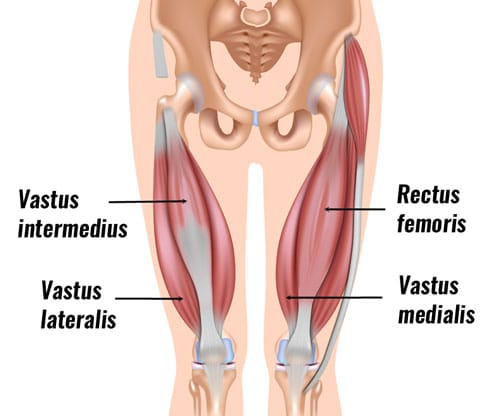
The four heads merge together, attach onto the patella (knee cap), and then insert via a single (patellar) tendon onto the tibia, just below the knee joint.
The quadriceps muscles are crucial in lower body movements such as walking, running, jumping, and squatting.
Takeaways
Strengthening and toning your quadriceps can improve knee stability, reduce the likelihood of knee injuries, improve athletic performance, and simplify daily activities.
Numerous quad exercises can be performed at home without any specialised equipment.
It is recommended to start slowly and gradually increase the number of reps or sets as you become more comfortable with the exercises.
References
- Marshall RN, Morgan PT, Martinez-Valdes E, Breen L. Quadriceps muscle electromyography activity during physical activities and resistance exercise modes in younger and older adults. Exp Gerontol. 2020 Jul 15;136:110965. doi: 10.1016/j.exger.2020.110965. Epub 2020 Apr 30. PMID: 32360986; PMCID: PMC7264709.
- Kilgas MA, DenHerder AE, Lytle LLM, Williams CT, Elmer SJ. Home-Based Exercise With Blood Flow Restriction to Improve Quadriceps Muscle and Physical Function After Total Knee Arthroplasty: A Case Report. Phys Ther. 2019 Nov 25;99(11):1495-1500. doi: 10.1093/ptj/pzz110. PMID: 31392999.
- Thomas Linding Jakobsen, Markus Due Jakobsen, Lars Louis Andersen: Quadriceps muscle activity during commonly used strength training exercises shortly after total knee arthroplasty: implications for home-based exercise-selection. J Exp Orthop. 2019 Dec
- Donnelly DV, Berg WP, Fiske DM. The effect of the direction of gaze on the kinematics of the squat exercise. J Strength Cond Res. 2006;20:145–150.
- Desiana, Istingadah & Moeliono, Marina & Prabowo, Tertianto. (2017). Effects of Quadriceps Strengthening Exercise on Quadriceps Muscle Strength and Its Relation to Lower Extremity Lean Mass. International Journal of Integrated Health Sciences. 5. 84-88. 10.15850/ijihs.v5n2.1010.
- Anatomy, Bony Pelvis and Lower Limb, Thigh Quadriceps Muscle

Manish is a NASM-certified fitness and nutrition coach with over 10 years of experience in weight lifting and fat loss fitness coaching. He specializes in gym-based training and has a lot of knowledge about exercise, lifting technique, biomechanics, and more.
Through “Fit Life Regime,” he generously shares the insights he’s gained over a decade in the field. His goal is to equip others with the knowledge to start their own fitness journey.
